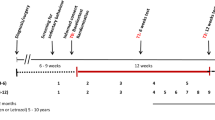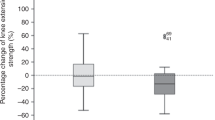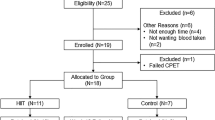Summary:
We report a pilot study of a home-based aerobic exercise program in a group of 17 adult hematopoietic stem cell transplant (HSCT) recipients. Participants had received no cancer treatment for at least 6 months and reported leisure time physical activity less than 20 min per day and fewer than three times a week during the previous month. Following baseline assessments of aerobic fitness, fatigue symptoms, and quality of life, participants were placed on home-based aerobic exercise programs consisting of 20–40 min of activity in the target heart rate zone (40–60% predicted heart rate reserve) delivered in three to five sessions per week for 12 weeks. Subjects were supplied with electronic heart rate monitors and we encouraged program adherence using weekly telephone contacts and exercise diaries. In all, 32 of the 42 qualified candidates consented (acceptance=76%). Of these, 17 kept appointments for baseline assessments, four did not complete the study (attrition=46%), and no exercise-related adverse events were reported. Scores on measures of aerobic fitness, fatigue severity, and physical well-being improved (signed ranks test; P<0.05) during program participation. Our findings suggest that individually prescribed, home-based aerobic exercise is an acceptable, safe, and potentially effective intervention for improving physical functioning and fatigue in sedentary HSCT recipients.
This is a preview of subscription content, access via your institution
Access options
Subscribe to this journal
Receive 12 print issues and online access
$259.00 per year
only $21.58 per issue
Buy this article
- Purchase on Springer Link
- Instant access to full article PDF
Prices may be subject to local taxes which are calculated during checkout

Similar content being viewed by others
References
Andrykowski MA, Greiner CB, Altmaier EM et al. Quality of life following bone marrow transplantation: findings from a multicentre study. Br J Cancer 1995; 71: 1322–1329.
Hann DM, Jacobsen PB, Martin SC et al. Quality of life following bone marrow transplantation for breast cancer: a comparative study. Bone Marrow Transplant 1997; 19: 257–264.
Hjermstad M, Holte H, Evensen S et al. Do patients who are treated with stem cell transplantation have a health-related quality of life comparable to the general population after 1 year? Bone Marrow Transplant 1999; 24: 911–918.
McQuellon RP, Russell GB, Rambo TD et al. Quality of life and psychological distress of bone marrow transplant recipients: the ‘time trajectory’ to recovery during the first year. Bone Marrow Transplant 1998; 21: 477–486.
Sutherland HJ, Fyles GM, Adams G et al. Quality of life following bone marrow transplantation: a comparison of patient reports with population norms. Bone Marrow Transplant 1997; 19: 1129–1136.
Whedon M, Stearns D, Mills LE . Quality of life of long-term adult survivors of autologous bone marrow transplantation. Oncol Nurs Forum 1995; 22: 1527–1535.
Wingard JR, Curbow B, Baker F, Piantadosi S . Health, functional status, and employment of adult survivors of bone marrow transplantation. Ann Intern Med 1991; 114: 113–118.
Andrykowski MA, Carpenter IS, Greiner CB et al. Energy level and sleep quality following bone marrow transplantation. Bone Marrow Transplant 1997; 20: 669–679.
Baker F, Wingard JF, Curbow B et al. Quality of life of bone marrow transplant long-term survivors. Bone Marrow Transplant 1994; 13: 589–596.
Kiss TL, Abdolell M, Jamal N et al. Long-term medical outcomes and quality-of-life assessment of patients with chronic myeloid leukemia followed at least 10 years after allogeneic bone marrow transplantation. J Clin Oncol 2002; 20: 2334–2343.
Knobel H, Loge JH, Nordoy T et al. High level of fatigue in lymphoma patients treated with high dose therapy. J Pain Symptom Manage 2000; 19: 446–456.
Molassiotis A, Morris P . Quality of life in patients with chronic myeloid leukemia after unrelated donor bone marrow transplant. Cancer Nurs 1999; 22: 340–349.
US Department of Health and Human Services. Physical Activity and Health: A Report of the Surgeon General. Atlanta, GA: US Department of Health and Human Services, Centers for Diseases Control and Prevention, National Center for Chronic Disease Prevention and Health promotion, 1996.
Patterson RE, Neuhouser ML, Hedderson MM et al. Changes in diet, physical activity, and supplement use among adults diagnosed with cancer. J Am Diet Assoc 2003; 103: 323–328.
Satia JA, Campbell MK, Galanko JA et al. Longitudinal changes in lifestyle behaviors and health status in colon cancer survivors. Cancer Epidemiol Biomarkers Prev 2004; 13: 1022–1031.
Pinto BM, Maruyama NC, Clark MM et al. Motivation to modify lifestyle risk behaviors in women treated for breast cancer. Mayo Clin Proc 2002; 77: 122–129.
Blanchard CM, Cokkinides V, Courneya KS et al. A comparison of physical activity of posttreatment breast cancer survivors and noncancer controls. Behav Med 2003; 28: 140–149.
Sleijfer S, de Wit R . Physical activity in long-term survivors of germ-cell cancer. Eur J Cancer 2003; 39: 1191–1193.
Thorsen L, Nystad W, Dahl O et al. The level of physical activity in long-term survivors of testicular cancer. Eur J Cancer 2003; 39: 1216–1221.
Courneya KS, Mackey JR, Bell GJ et al. Randomized controlled trial of exercise training in postmenopausal breast cancer survivors: cardiopulmonary and quality of life outcomes. J Clin Oncol 2003; 21: 1660–1668.
Dimeo F, Fetscher S, Lange W et al. Effects of aerobic exercise on the physical performance and incidence of treatment-related complications after high-dose chemotherapy. Blood 1997; 90: 3390–3394.
Dimeo F, Tilmann MHM, Bertz H et al. Aerobic exercise in the rehabilitation of cancer patients after high dose chemotherapy and autologous peripheral stem cell transplantation. Cancer 1997; 79: 1717–1722.
Dimeo FC, Stieglitz RD, Novelli-Fischer U et al. Effects of physical activity on the fatigue and psychologic status of cancer patients during chemotherapy. Cancer 1999; 85: 2273–2277.
MacVicar MG, Winningham ML, Nickel JL . Effects of aerobic interval training on cancer patients' functional capacity. Nurs Res 1989; 38: 348–351.
Mock V, Pickett M, Ropka ME et al. Fatigue and quality of life outcomes of exercise during cancer treatment. Cancer Pract 2001; 9: 119–127.
Segal R, Evans W, Johnson D et al. Structured exercise improves physical functioning in women with stages I and II breast cancer: results of a randomized controlled trial. J Clin Oncol 2001; 19: 657–665.
Segar ML, Katch VL, Roth RS et al. The effect of aerobic exercise on self-esteem and depressive and anxiety symptoms among breast cancer survivors. Oncol Nurs Forum 1998; 25: 107–113.
Winningham ML, MacVicar MG . The effect of aerobic exercise on patient reports of nausea. Oncol Nurs Forum 1988; 15: 447–450.
Winningham ML, MacVicar MG, Bondoc M et al. Effect of aerobic exercise on body weight and composition in patients with breast cancer on adjuvant chemotherapy. Oncol Nurs Forum 1989; 16: 683–689.
Courneya KS, Keats MR, Turner AR . Physical exercise and quality of life in cancer patients following high dose chemotherapy and autologous bone marrow transplantation. Psychooncology 2000; 9: 127–136.
Dimeo F, Bertz H, Finke J et al. An aerobic exercise program for patients with haematological malignancies after bone marrow transplantation. Bone Marrow Transplant 1996; 18: 1157–1160.
Mello M, Tanaka C, Dulley FL . Effects of an exercise program on muscle performance in patients undergoing allogeneic bone marrow transplantation. Bone Marrow Transplant 2003; 32: 723–728.
Courneya KS, Friedenreich CM . Physical exercise and quality of life following cancer diagnosis: a literature review. Ann Behav Med 1999; 21: 171–179.
Courneya KS, Mackey JR, Quinney HA . Neoplasms. In: Myers J, Herbert W, Humphrey R (eds). American College of Sports Medicine's Resources for Clinical Exercise Physiology: Musculoskeletal, Neuromuscular, Neoplastic, Immunologic, and Hematologic Conditions. Lippincott: New York, 2002, pp 179–191.
American College of Sports Medicine. Position stand on the recommended quantity and quality of exercise for developing and maintaining cardiorespiratory and muscular fitness in adults. Med Sci Sports Exerc 1998; 30: 975–991.
Ware JE . SF-36 Health Survey: Manual and Interpretation Guide. The Health Institute, New England Medical Center: Boston, 1993.
Ware JE, Kosinski M, Keller SD . SF-36 Physical and Mental Health Summary Scales: A User's Manual. The Health Institute, New England Medical Center: Boston, 1994.
Hann DM, Jacobsen PB, Azzarello LM et al. Measurement of fatigue in cancer patients: Development and validation of the Fatigue Symptom Inventory. Qual Life Res 1998; 7: 301–310.
Hann DM, Denniston MM, Baker F . Measurement of fatigue in cancer patients: further validation of the Fatigue Symptom Inventory. Qual Life Res 2000; 9: 847–854.
Hann DM, Garavoy N, Finklestein B et al. Fatigue and quality of life in breast cancer patients undergoing autologous stem cell transplantation: a longitudinal comparative study. J Pain Symptom Manage 1999; 17: 311–319.
Davis JA, Storer TW, Caiozzo VJ . Prediction of normal values for lactate threshold estimated by gas exchange in men and women. Eur J Appl Physiol Occup Physiol 1997; 76: 157–164.
Gaskill SE, Ruby BC, Walker AJ et al. Validity and reliability of combining three methods to determine ventilatory threshold. Med Sci Sports Exerc 2001; 33: 1841–1848.
Shimizu M, Myers J, Buchanan N et al. The ventilatory threshold: method, protocol, and evaluator agreement. Am Heart J 1991; 122: 509–516.
Franklin BA, Whaley MH, Howley ET (eds). ACSM's Guidelines for Exercise Training and Prescription, 6th edn. Lippincott, Williams and Wilkins: Philadelphia, 2000, p 145.
NHLBI Obesity Task Force. Clinical guidelines on the identification, evaluation, and treatment of overweight and obesity in adults – the evidence report. Obes Res. 1998; 6 (Suppl 2): 51S–209S.
World Health Organization. Obesity: preventing and managing the global epidemic. Report of a WHO Consultation Presented at: the World Health Organization, June 3–5, 1997, Geneva, Switzerland. Publication WHO/NUT/NCD/98.1.
Shvartz E, Reibold RC . Aerobic fitness norms for males and females aged 6 to 75 years: a review. Aviat Space Environ Med 1990; 61: 3–11.
Gaskill SE, Rice T, Bouchard C et al. Familial resemblance in ventilatory threshold: the HERITAGE Family Study. Med Sci Sports Exerc 2001; 33: 1832–1840.
Must A, Spadano J, Coakley EH et al. The disease burden associated with overweight and obesity. JAMA 1999; 282: 1523–1529.
Courneya KS . Exercise intervention during cancer treatment: biopsychosocial outcomes. Exerc Sports Sci Rev 2001; 29: 60–64.
Nagi S . Disability Concepts Revisited: Implications for Prevention. Disability in America: Toward a National Agenda for Prevention. National Academy Press: Washington, 1991 pp 309–327.
Verbrugge LM, Jette AM . The disablement process. Soc Sci Med 1994; 38: 1–14.
Pinto BM, Trunzo JJ . Body esteem and mood among sedentary and active breast cancer survivors. Mayo Clin Proc 2004; 79: 181–186.
Acknowledgements
The authors gratefully acknowledge Zoë Swain and Iryna Watson for their assistance with recruitment and data collection.
Author information
Authors and Affiliations
Corresponding author
Rights and permissions
About this article
Cite this article
Wilson, R., Jacobsen, P. & Fields, K. Pilot study of a home-based aerobic exercise program for sedentary cancer survivors treated with hematopoietic stem cell transplantation. Bone Marrow Transplant 35, 721–727 (2005). https://doi.org/10.1038/sj.bmt.1704815
Received:
Accepted:
Published:
Issue Date:
DOI: https://doi.org/10.1038/sj.bmt.1704815
Keywords
This article is cited by
-
Potential benefits of a virtual, home-based combined exercise and mindfulness training program for HSC transplant survivors: a single-arm pilot study
BMC Sports Science, Medicine and Rehabilitation (2022)
-
Evaluation of indices for predicting recovery of exercise tolerance in patients surviving allogenic hematopoietic stem cell transplantation
Supportive Care in Cancer (2022)
-
Deconditioning, fatigue and impaired quality of life in long-term survivors after allogeneic hematopoietic stem cell transplantation
Bone Marrow Transplantation (2018)
-
The role of physical rehabilitation in stem cell transplantation patients
Supportive Care in Cancer (2015)
-
Effect of exercise therapy on muscle mass and physical functioning in patients undergoing allogeneic hematopoietic stem cell transplantation
Supportive Care in Cancer (2015)



